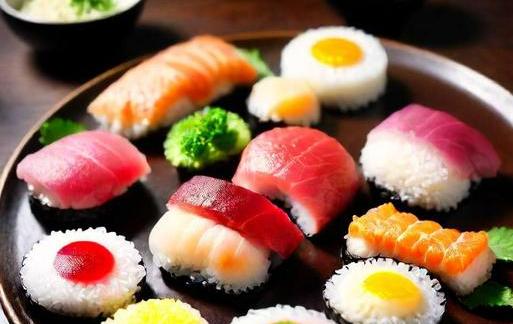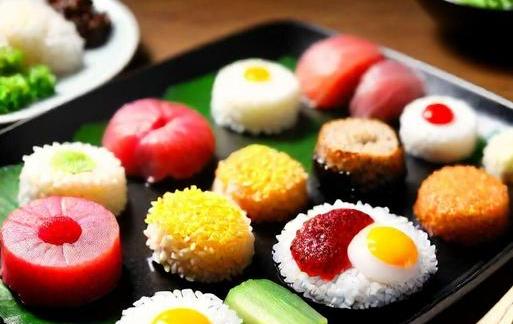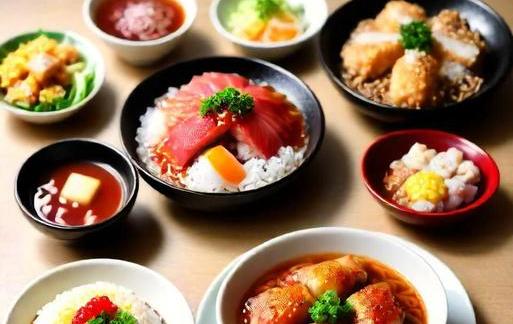- You are here:
- Home »
- Food
- » [REVEALED] Japanese Foods That Start With D
[REVEALED] Japanese Foods That Start With D
Note: This page contains affiliate links.
As an Amazon Associate, I earn from qualifying purchases when you click on the link, but you are not charged extra.
Japanese cuisine is renowned for its exquisite flavors, meticulous preparation, and diverse range of dishes. From sushi and ramen to tempura and sashimi, Japan boasts a rich culinary heritage that has captivated taste buds worldwide. In this gastronomic exploration, we delve into the lesser-known realm of Japanese foods that start with the letter "D." While not as prominent as some other culinary categories, these dishes offer a unique and delightful experience for those seeking to broaden their understanding of Japanese gastronomy.
Contents
List Of Japanese Foods That Start With D

1. Dango (団子)
Description: Dango is a traditional Japanese sweet made from glutinous rice flour. These chewy rice dumplings are typically served on skewers and come in various colors and flavors. The most common types of dango include mitarashi dango (coated in a sweet soy glaze) and anko dango (filled with sweet red bean paste).
Preparation: To make dango, glutinous rice flour is mixed with water to form a sticky dough. The dough is then shaped into small balls, boiled, and skewered. The skewers are often grilled or coated with various toppings to enhance the flavor.
2. Daikon Radish (大根)
Description: Daikon radish is a staple in Japanese cuisine, prized for its crisp texture and mild flavor. This versatile vegetable is often used in salads, pickles, and as a garnish. Daikon is an integral part of traditional Japanese dishes like oden and tsukemono (pickles).
Preparation: Daikon radish can be enjoyed raw, sliced into salads or grated as a condiment. It is also a common ingredient in simmered dishes, where it absorbs the flavors of the broth, adding a subtle sweetness to the overall taste.
3. Donburi (丼)
Description: Donburi refers to a Japanese dish consisting of a bowl of rice topped with various ingredients, typically meat, vegetables, and eggs. There are numerous types of donburi, each with its distinct name, such as gyudon (beef bowl), katsudon (tonkatsu, or breaded and fried pork cutlet, bowl), and oyakodon (chicken and egg bowl).
Preparation: The preparation of donburi involves cooking the desired ingredients and placing them over a bowl of steamed rice. A flavorful sauce, often a combination of soy sauce, mirin, and dashi, is poured over the toppings, infusing the entire dish with umami goodness.
4. Dorayaki (どら焼き)
Description: Dorayaki is a popular Japanese confection consisting of two fluffy pancake-like cakes sandwiched together with sweet red bean paste. This delightful sweet treat is not only enjoyed by locals but has also gained popularity worldwide.
Preparation: To make dorayaki, a batter of flour, sugar, and eggs is poured onto a griddle, creating small, round pancakes. These cakes are then filled with sweet red bean paste and pressed together, resulting in a delicious, portable dessert.
5. Dashi (だし)
Description: Dashi is a fundamental ingredient in Japanese cooking, serving as the base for many soups, stews, and sauces. It is a broth made from simmering ingredients such as bonito flakes, kombu (dried kelp), and dried fish. Dashi contributes a savory, umami-rich flavor to a wide array of Japanese dishes.
Preparation: There are several methods for preparing dashi, with the two most common being ichiban dashi and niban dashi. Ichiban dashi is the first extraction from the simmering process and is considered the highest quality, while niban dashi is a second extraction used in heartier dishes.
6. Dorome (ドロメ)
Description: Dorome, also known as "Dried Roe," is a traditional Japanese ingredient made by drying fish roe, typically from flying fish or mullet. This delicacy is used to enhance the flavor of various dishes and is a favorite among those who appreciate the unique taste and texture of roe.
Preparation: The preparation of dorome involves carefully salting and drying the fish roe. Once dried, it can be grated or sprinkled over dishes like rice, noodles, or salads, imparting a burst of briny flavor.
7. Dote Nabe (土手鍋)
Description: Dote Nabe is a regional dish hailing from the Hiroshima Prefecture. It is a hot pot dish featuring a variety of ingredients such as vegetables, tofu, and thinly sliced pork belly, all cooked in a savory miso-based broth. Dote Nabe is a comforting and communal dish enjoyed during colder months.
Preparation: The preparation involves arranging the ingredients in a decorative manner on a large plate or tray. The diner then takes the desired portions and cooks them in a shared pot of simmering miso broth, creating a warm and communal dining experience.
8. Dried Shiitake Mushrooms (干し椎茸)
Description: Dried Shiitake Mushrooms are a pantry staple in Japanese households. These mushrooms are prized for their intense flavor and are used in a variety of dishes, including soups, stews, and rice dishes. The drying process enhances their umami taste, making them a versatile and essential ingredient.
Preparation: To use dried shiitake mushrooms, they are typically rehydrated by soaking in water. The rehydrated mushrooms can then be sliced and added to soups or stir-fries, imparting a rich and earthy flavor to the dish.
In the realm of Japanese cuisine, the exploration of foods that start with the letter "D" unveils a diverse array of flavors and textures. From the sweet and chewy dango to the comforting warmth of Dote Nabe, each dish brings its unique contribution to the rich tapestry of Japanese gastronomy. Whether you are a seasoned food enthusiast or a curious novice, these culinary delights offer a fascinating journey into the less-explored corners of Japanese cuisine. As you embark on this culinary adventure, savor the flavors, appreciate the artistry, and relish in the cultural nuances that make Japanese food a global treasure.
Significance

Japan, a land of rich cultural heritage and gastronomic delights, offers a diverse array of foods that captivate the taste buds. In this culinary journey, we delve into the world of Japanese foods that start with the letter "D." From traditional delights to modern culinary innovations, each dish holds a unique place in Japan’s culinary landscape. Join us as we explore the significance, categorization, common themes, interesting facts, and conclude our exploration of these delectable "D" dishes.
Japanese cuisine is celebrated worldwide for its emphasis on fresh, seasonal ingredients and meticulous preparation techniques. The significance of foods that start with "D" in Japanese culinary traditions is rooted in a commitment to balance, umami, and aesthetic presentation.
"Dashi," a fundamental component in Japanese cooking, epitomizes the essence of umami. This savory broth serves as the foundation for many dishes, showcasing the Japanese dedication to extracting complex flavors from simple ingredients like kombu (seaweed) and bonito flakes.
Delicacies starting with "D" are also often intertwined with cultural rituals and ceremonies. From celebratory feasts to daily nourishment, these dishes reflect the harmony between nature and cuisine, highlighting the profound connection the Japanese people have with their food.
Category-Related

1. Dashi (出汁)
Description:
Dashi, the quintessential Japanese broth, is a cornerstone in many traditional dishes. Crafted from kombu (kelp) and katsuobushi (fermented skipjack tuna), it serves as a flavorful base for soups, stews, and sauces. The umami-rich profile of dashi enhances the taste of various Japanese delicacies.
Preparation:
The preparation involves soaking kombu in water and then simmering it with katsuobushi. The resulting liquid is strained, leaving behind a versatile and aromatic broth.
Usage:
Dashi is a key component in dishes like miso soup, udon, and tempura dipping sauce. Its umami depth elevates the overall taste, making it an indispensable ingredient in Japanese cuisine.
2. Daikon Radish (大根)
Description:
Daikon, a large white radish, is a staple in Japanese cuisine. Its mild flavor and crisp texture make it a versatile ingredient. Whether raw, pickled, or cooked, daikon adds a refreshing element to various dishes.
Preparation:
Daikon can be grated and served as a garnish or thinly sliced for salads. It is also pickled to create "takuan," a popular accompaniment to rice dishes.
Usage:
From being a key component in nabemono (hot pot dishes) to adding a crunchy element to sashimi, daikon’s versatility makes it an essential ingredient in Japanese kitchens.
3. Dorayaki (どら焼き)
Description:
Dorayaki, a beloved Japanese confection, is a sweet pancake sandwich filled with anko (sweet red bean paste). With a fluffy texture and a perfect balance of sweetness, dorayaki is a popular treat enjoyed by people of all ages.
Preparation:
The pancake batter is made with flour, sugar, and eggs, creating a light and airy texture. After cooking in a special mold, two pancakes are sandwiched together with a generous filling of anko.
Usage:
Dorayaki is commonly found in Japanese dessert shops and is also a favorite snack for special occasions. Its popularity has even transcended borders, finding fans beyond Japan.
Common Themes
Japanese foods that start with "D" often share common themes that echo the principles of Japanese culinary artistry.
1. Balance Of Flavors
Japanese cuisine is renowned for its emphasis on achieving a delicate balance of flavors. Whether it’s the savory notes of dashi in a bowl of miso soup or the sweet and earthy tones of anko in dorayaki, each dish strives to harmonize contrasting tastes.
2. Artful Presentation
The meticulous presentation of dishes, known as "shokunin," is a prevalent theme in Japanese culinary culture. Foods starting with "D" are no exception. From the vibrant colors of pickled daikon to the symmetrical perfection of dorayaki, visual appeal is an integral aspect of the dining experience.
3. Seasonal Variation
Japanese cuisine celebrates the changing seasons, and this theme is evident in "D" dishes as well. Seasonal ingredients like daikon are incorporated into dishes based on their freshness and availability, creating a connection between the plate and the natural world.
Interesting Facts
Uncovering the nuances and lesser-known facets of Japanese foods that start with "D" reveals intriguing insights into the country’s culinary heritage.
1. Dango (団子) Diversity
Fact:
Dango, a type of sweet dumpling, comes in various colors and flavors. Known for its chewy texture, these dumplings are often skewered and enjoyed during festivals or as a delightful snack.
Varieties:
There are different types of dango, such as mitarashi dango (coated in a sweet soy glaze), hanami dango (colored in pastel hues), and kibi dango (made with millet flour). Each variety reflects regional influences and cultural traditions.
2. Diverse Uses Of Dashi
Fact:
While dashi is commonly associated with soups and stews, its versatility extends to unexpected culinary realms. Some chefs use dashi to infuse flavor into Western dishes like risotto, showcasing its adaptability in the global culinary landscape.
Creative Applications:
In addition to savory dishes, dashi is utilized in sweet recipes, adding a subtle umami undertone to desserts like custards and jellies. This unexpected twist demonstrates the versatility of this seemingly simple broth.
3. Dazzling Daikon Artistry
Fact:
Daikon radishes are not only culinary ingredients but also artistic canvases. In the town of Yonezawa, daikon farmers craft intricate sculptures from these radishes, transforming them into dragons, animals, and even characters from Japanese folklore.
Cultural Expression:
This tradition not only showcases agricultural creativity but also serves as a form of cultural expression, intertwining agriculture with art in a unique and visually captivating way.
Conclusion
In the realm of Japanese cuisine, foods that start with the letter "D" embody a rich tapestry of flavors, cultural significance, and culinary artistry. From the foundational role of dashi to the diverse uses of daikon and the sweet delights of dorayaki, each dish contributes to the mosaic of Japanese gastronomy.
As we conclude our exploration, it becomes apparent that the foods beginning with "D" are not just mere ingredients but carriers of tradition, stories, and a profound connection to nature. Whether enjoyed in the serene setting of a traditional tea ceremony or in the hustle and bustle of a modern metropolis, these dishes serve as ambassadors of Japanese culinary excellence, inviting us to savor the essence of a culture steeped in tradition and innovation.


